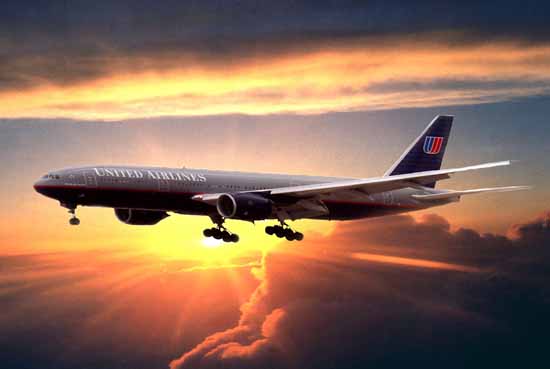This Aircraft flown by Capt. Rick S. Rubin 09-23-2000

The 777 family is designed to fill the size
gap between the 767 and 747. The
market-driven 777-200 twinjet seats from
305 to 328 passengers in a typical
three-class configuration. The initial
777-200, which was first delivered in May
1995, has a range of up to 5,925 miles.
The 777-200ER (extended range) was first
delivered in February 1997. This model is capable
of flying the same number of passengers up to
8,861 miles.
The latest 777 derivative is the 777-300, a
stretched version that provides seating for 328 to 394
passengers in a typical three-class configuration. The first
airplane was delivered in May 1998.
The recently launched 777-200 and -300
Longer-Range Derivatives bring the
popular twinjets from Boeing Commercial
Airplanes Group to new markets.
Continuing the tradition of the 777, these
newest airplanes fulfill the original vision
of the 777 family plan. The 777-200 derivative will be the
longest-range airplane in the world, while the 777-300
derivative will be the ideal replacement for early 747s.
Proposed first delivery will be late 2003 (first model, with the
second model following four to six months later).
EVERETT, Wash., June 7, 2000 - Five years ago today, a United
Airlines (UAL) Boeing 777 departed London on a flight to Washington,
D.C., marking a new era in air travel.
The passengers who boarded UAL Flight 921 that morning for the first
commercial flight of the Boeing 777 entered the newest, most
technologically advanced and most comfortable jetliner ever built. Flying
at 84 percent of the speed of sound, the Boeing 777 got them to their
destination more quickly than any jetliner in its class. During the flight,
they
enjoyed their choice of entertainment on the seat-back in-flight
entertainment system.
Since that flight, the Boeing 777 has established itself as the world's
leading intermediate- and long-range jetliner.
In a recent assessment of the 777s in its fleet, United Airlines said that
Boeing had built a truly great airplane.
"During the past five years, the 777 has been consistently voted best in
show by our passengers, our pilots, flight attendants, mechanics and - not
to be forgotten - our accountants. It is the current benchmark against
which all other commercial transports are measured, and has become the
industry standard for all future designs," said Gordon McKinzie, United's
manager of New Aircraft Development.
Since the 777 Program was launched in 1990, the airplane has logged
more than 460 orders, about 62 percent of the total market.
The Boeing 777 comes in three models, capable of flying a variety of
ranges. In a typical three-class configuration, the 777-200 carries 305
passengers up to 5,150 nautical miles (9,525 kilometers). The
777-200ER (extended range) carries the same number of passengers up
to 7,700 nautical miles (14,260 kilometers) - the greatest range of any
commercial jetliner. A similarly configured 777-300 carries 368
passengers up to 5,960 nautical miles (11,030 kilometers).
New, even longer range versions of the Boeing 777 will be delivered
beginning in late 2003, linking cities as far as 8,860 nautical miles (16,408
kilometers) apart. For passengers, that range will make it possible to fly
non-stop to almost any destination in the world.
The Boeing 777 worldwide fleet, consisting of more than 280 airplanes,
has flown a total of more than 2 million hours, with each airplane flying
an
average of 10 hours a day. With this rigorous workout, the fleet has
achieved an impressive schedule reliability rate of 99 percent - the best
in
its class. This is an unprecedented rate for an airplane of this size and
complexity at this point in its commercial service.
"After five years in service, this remarkable airplane speaks for itself as
a
preferred product to our customers, the airlines, as well as to their
customers, the passenger," said Ron Ostrowski, vice president and
program manager of the Boeing 777 Program.
Ostrowski also observed that the airplane's exceptional performance in
service speaks well for its guiding principle, "Working Together."
"With the airlines' participation early on in the program, we were able to
design an airplane that beats the competition hands down on reliability,
performance, economical operation and comfort," Ostrowski said.
With its twin-engine efficiencies, the 777 offers airlines superior economic
performance. The 777 has seven to 13 percent lower seat-mile costs and
four to 12 percent lower fuel burn per seat when compared to its
competitors.
The 777's speed advantage over the competition saves passengers 30
minutes or more on long flights such as between London and Singapore,
which minimizes traveler fatigue and reduces anxiety for passengers
making a connecting flight to their final destinations.
From the beginning, the 777 has been recognized for its award-winning
spacious interior - the first airline interior to be honored by the Industrial
Designers Society of America. The 777 has set a new standard for
comfort in airline travel with the widest seats, more headroom, more
efficient stowage and a more spacious environment.
Return to Aviation Page